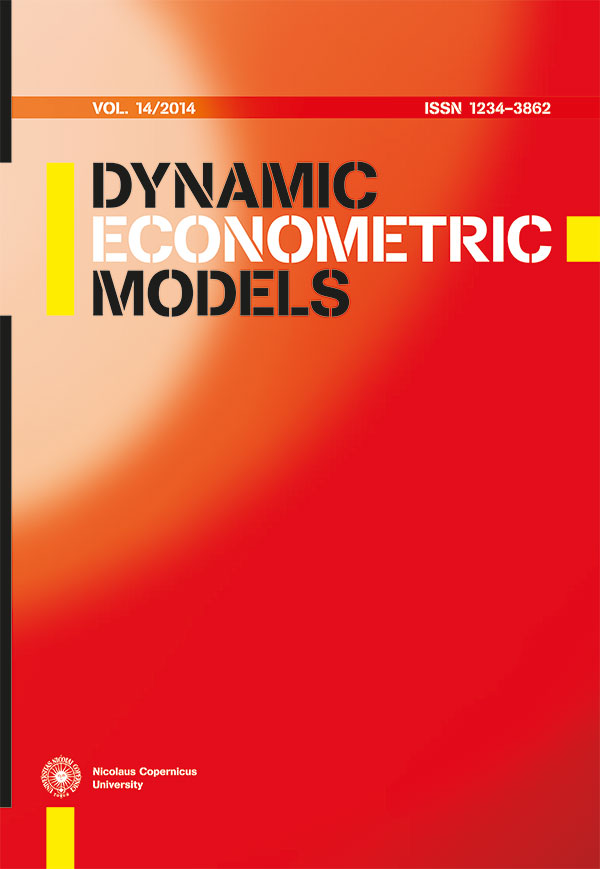The Application of Hidden Markov Models to the Analysis of Real Convergence
DOI:
https://doi.org/10.12775/DEM.2017.004Keywords
catching-up, convergence, hidden Markov model, European Union, Viterbi path.Abstract
This paper employs hidden Markov models and the Viterbi path to analyze the process of real convergence. Such an approach combines the analysis of cyclical and income-level convergence. Twelve macroeconomic variables in the sample of 28 EU countries observed in the 1995-2016 period are within the scope of the study. The results indicate, among others, the existence of real convergence of Poland toward the remaining EU countries in terms of the levels of GDP per capita at PPP and GDP growth rates, with a short-run period of divergence during the global crisis.References
Barro, R., Sala-i-Martin, X. (2003), Economic Growth, The MIT Press, Cambridge–London.
Battisti, M., Parmeter, Ch.F. (2013), Clustering and Polarization in the Distribution of Output: A Multivariate Perspective, Journal of Macroeconomics, 35, 144-162, DOI: http://dx.doi.org/10.1016/j.jmacro.2012.10.003.
Baum, L.E., Petrie, T., Soules, G., Weiss, N. (1970), A Maximization Technique Occurring in the Statistical Analysis of Probabilistic Functions of Markov Chains, The Annals of Mathematical Statistics, 41, no. 1, 164-171, DOI: http://dx.doi.org/10.1214/aoms/1177697196.
Bernardelli, M. (2013), Non-classical Markov Models in the Analysis of Business Cycles in Poland. “Roczniki” Kolegium Analiz Ekonomicznych SGH (Annals the Collegium of Economic Analysis), Oficyna Wydawnicza SGH, 30, 59-74.
Bernardelli, M., Dędys, M. (2012), Hidden Markov Models in Analysis of Results of Business Tendency Surveys. Badanie koniunktury – zwierciadło gospodarki, cz. 1, Prace i Materiały Instytutu Rozwoju Gospodarczego, no. 90, 159-181.
Borsi, M.T., Metiu, N. (2013), The Evolution of Economic Convergence in the European Union, Deutsche Bundesbank Discussion Paper, no. 28/2013, https://www.bundesbank.de/Redaktion/EN/Downloads/Publications/Discussion_Paper_1/2013/2013_08_13_dkp_28.pdf?__blob=publicationFile (10.02.2017).
Cappé, O., Moulines, E., Rydén, T. (2005), Inference in Hidden Markov Models, Springer Series in Statistics, Springer, DOI: http://dx.doi.org/10.1007/0-387-28982-8.
Chauvet M., Hamilton J.D., (2005), Dating Business Cycle Turning Points, NBER Working Paper Series, Working Paper 11422, http://www.nber.org/papers/w11422 (20.02.2017), DOI: http://dx.doi.org/10.3386/w11422.
European Commission (2016), Statistical Annex of European Economy, Autumn 2016, https://ec.europa.eu/info/files/statistical-annex-european-economy-autumn-2016_en (17.02.2017).
Hamilton, J.D. (1989), A New Approach to the Economic Analysis of Non-stationary Time Series and Business Cycle. Econometrica, no. 57, 357-384.
Hamilton, J.D. (1994), Time Series Analysis. Princeton University Press, Princeton, New Jersey.
Harding D., Pagan A., (2002), A Comparison of Two Business Cycle Dating Methods, Journal of Economic Dynamics and Control, no. 27, 1681-1690, DOI: http://dx.doi.org/10.1016/S0165-1889(02)00076-3.
IMF (2017), World Economic Outlook Database, October 2016 (updated 16 January 2017), https://www.imf.org/external/pubs/ft/weo/2016/02/weodata/index.aspx (30.01.2017).
Islam, N. (2003), What Have We Learnt from the Convergence Debate?, Journal of Economic Surveys, 17(3), 309-362, DOI: http://dx.doi.org/10.1111/1467-6419.00197.
Koskinen, L., Oeller, L.E. (2004), A Classifying Procedure for Signaling Turning Points, Journal of Forecasting, 23, 197–214, DOI: http://dx.doi.org/10.1002/for.905.
Matkowski, Z., Próchniak, M., Rapacki, R. (2016), Income Convergence in Poland vis-à-vis the EU: Major Trends and Prospects, in Weresa M.A. (ed.), Poland. Competitiveness Report 2016. The Role of Economic Policy and Institutions, Warsaw, World Economy Research Institute, SGH Warsaw School of Economics.
Monfort, M., Cuestas, J.C., Ordóñez, J. (2013), Real Convergence in Europe: A Cluster Analysis, Economic Modelling, 33, 689-694, DOI: http://dx.doi.org/10.1016/j.econmod.2013.05.015.
Mucha, M. (2012), Mechanizm dywergencji gospodarczej w strefie euro (Mechanism of Economic Divergence in the Euro Area), Ekonomista, 4, 487-498.
Staňisić, N. (2012), The Effects of the Economic Crisis on Income Convergence in the European Union, Acta Oeconomica, 62(2), 161-182, DOI: http://dx.doi.org/10.1556/AOecon.62.2012.2.2.
Viterbi, A. (1967), Error Bounds for Convolutional Codes and an Asymptotically Optimum Decoding Algorithm, IEEE Transactions on Information Theory, 13, 260-269, DOI: http://dx.doi.org/10.1109/TIT.1967.1054010.
World Bank (2017), World Development Indicators Database, http://databank.worldbank.org (30.01.2017).
Zarnowitz, V., Ozyildirim, A. (2006), Time Series Decomposition and Measurement of Business Cycles, Trends and Growth Cycles, Journal of Monetary Economics, 53(7), 1717-1739, DOI: http://dx.doi.org/10.1016/j.jmoneco.2005.03.015.
Downloads
Published
How to Cite
Issue
Section
License
The journal provides an Open Access to its content based on the non-exclusive licence Creative Commons (CC BY-ND 4.0).
To enable the publisher to disseminate the author's work to the fullest extent, the author must agrees to the terms and conditions of the License Agreement with Nicolaus Copernicus University.
Stats
Number of views and downloads: 762
Number of citations: 0



